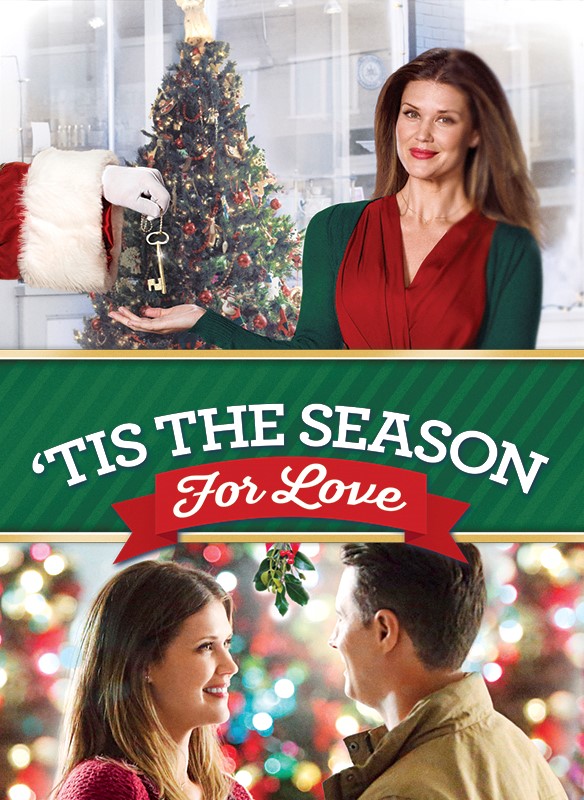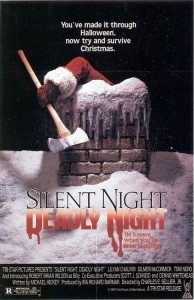‘Tis the Season: A Pro-White, Pro-Natal TV Movie
 Last year just before Christmas a movie caught my attention because it’s one of the rare pro-White modern Christmas movies, and, for added surprise, it is also pro-natal. Try to name any Hollywood film or any kind of TV fare that fits that bill.
Last year just before Christmas a movie caught my attention because it’s one of the rare pro-White modern Christmas movies, and, for added surprise, it is also pro-natal. Try to name any Hollywood film or any kind of TV fare that fits that bill.
The movie is called ‘Tis the Season for Love (2015) and it comes from the Hallmark Channel.
In this day and age with the war on Christmas in full swing and at a time when births to White parents are way, way down historically, what a treat it is to have one movie straight out of the maw of our entertainment industry that shows for one woman, life in a small town with a traditional man beats out the “You Go, Girl” life of a single woman in New York City. And there is not an ounce of irony in the entire movie.
Here is Hallmark’s summary of the show:
Beth Baker is an out-of-work actress stuck in New York City without her friends at Christmas time. She decides to return home to the quaint small town she escaped 10 years before and finds a place far different than the hamlet she left. She suddenly finds performing possibilities and even romance that kind of blow her away. Will the holidays prove to be as magical for Beth as they appear, or is Christmas magic doomed to disappear as quickly as it arrived for a lady who is ready to take chances she could never have imagined a decade before? Then again, this is the kind of thing that seems to happen during the Christmas season all the time.
Further, this movie got some serious numbers—2.3 million viewers at its debut three years ago. As far as I can tell, there has been no backlash against the movie, its actors, or its creators, and this year Hallmark again ran it. My own motive for highlighting this movie is to give TOO readers a small Christmas present as we head into the thick of the Christmas season. To be honest, so much of my own cultural criticism has been negative and pessimistic — if only because circumstances and honesty dictate it. So I’d like to offer something positive at this wonderful time of year.

Christmas Morning with White Mom and Dad and White Twins — and no irony
Storyline
‘Tis the Season begins in a swank apartment in New York City, with Beth and her gorgeous female roommate once again discussing Beth’s lack of career progress. While the roommate owns the expensive apartment and has realized success on Broadway, Beth is still sleeping on the couch and waiting tables. Incidentally, thoughts of children are entirely absent in this setting.
Because she doesn’t want Beth to spend Christmas alone, the obviously wealthy roommate gives Beth tickets home to Kern, Beth’s small hometown somewhere out in the heartland. When Beth gets there, we see an idyllic town full of Christmas decorations and White people wherever you might look. Beth’s mother is a widow, happily living alone among people she has known her whole life, and together mother and daughter visit the local lot where Christmas trees are sold. Straight off, Beth runs into her high school flame Barry, but Barry is now married to an attractive blonde, and they have a little blonde daughter named Taylor. Fortunately, there are no hard feelings among them.

Joining Barry and his wife is Dean, another friend from high school who Beth had never really noticed before. Like Barry, he is handsome and always wears attractive clothes, just like all the adults in the movie. Dean was married, but his hometown wife left him for another guy, so he’s now a single guy heading up the local fire department. At first, Barry and his wife, Beth and Dean go out for drinks and fun, but there is no hint of romance. This gradually changes, however, and we have the main plot of our movie.
Again, I have to stress how stunningly White the show is. Every last adult in Kern with any sort of speaking part is an attractive White, and they are all shown with wonderful qualities. The man playing Santa at the Christmas tree lot, for instance, is a charming White man, and he sagely listens to Beth’s plaints about her career. In response, he gives her a “magic” key that allows her to have special dreams about her future, and the first dream we see is that she has healthy White twin boys. The unknown identity of the father constitutes some of the ongoing drama in the film.
Unlike most other screen portrayals of family life in a small town, “Tis the Season shows not an ounce of negativity or departure from traditional values — no bickering, neuroses, drug use, foul language, kinky sex, gay marriage, murderous rage, twisted religious beliefs or racial mixing. When Beth and Dean visit Barry’s house, for instance, the downstairs is tastefully decorated for Christmas, Barry is tender toward his wife and daughter, and the wife is happily working in the kitchen. This is only one of many such scenes shown in contrast to the sterile, insincere life in New York City.
In addition to showing two-year-old Taylor, the adorable blonde daughter, the movie also focuses on the town’s children when Beth gets tasked with helping put on the annual Christmas festival. Rehearsals are upbeat, and Christmas is clearly the point of the play, not some smarmy “holiday season” theme.
Unfortunately, the children’s festival is also the one place in the movie where non-Whites make a marked intrusion, for close to half of the kids in the play are various shades of brown. Sadly, this is an accurate portrayal of today’s America, where already half or more of the young children are no longer White. This is going to be America’s future, too. Still, it is a minor image, and none of the brown children say anything. Along with one Black fireman, his wife and child, plus a another non-White carrying Christmas trees, there are no other depictions of non-Whites in the ideal White town of Kern. Again, I noticed these faces because that’s what I study, but I’d say your normal viewer would hardly notice, given the far, far greater emphasis on White roles.
By halfway through the movie, we have two competing themes: Beth falling for Dean (though her special dreams still don’t show who she’ll marry) vs. her long-held dream of making it big in New York. And thanks to a phone call from her swarthy agent Bill, it appears Beth is even less likely to realize her big-city dreams. She didn’t get the part she had longed for — and Bill is quitting as her agent. Things are looking up for the prospect of Beth settling down in her hometown.

Yes indeed, her chances of again becoming a resident of Kern increase when she and Dean find themselves ice skating alone one night at the ice rink of her childhood, and there she and Dean enjoy their first kiss. That night, she again has a special dream and here she sees that the father of her twins is none other than Dean.
Things only get better in Kern. The Christmas cheer is growing, and a group of carolers even sing the following:
Hark! the herald angels sing,
“Glory to the new-born King!
Peace on earth, and mercy mild,
God and sinners reconciled.”
While this does not directly mention Christ’s name, it has a very Christian theme.
Finally, we reach the climax of the movie when Bill the agent again calls and tells Beth that the understudy of a Broadway show has broken her leg and Beth is immediately needed as a replacement. What will Beth do? Stay with Dean and realize her small town destiny? Or jump at the chance to fulfill her dreams of a Broadway breakthrough?
She chooses the latter, but ‘Tis the Season uses this development to show how thoroughly Beth has opted for family life in a nice White town. Back in New York, we meet a group of insincere, unconnected multicultural individuals, beginning with the likely homosexual director of the play. Behind him stand a Black man and assorted other people from all over the globe. The director is uncaring, remarking that the understudy had broken her arm . . . or leg, or something. He then showers Beth with clearly insincere praise, all the while rushing to get things done. No wonder Beth that night has a dream about her New York life where the apartment is sterile and bare, and the refrigerator empty. What a contrast to the home-cooked meals in Kern and the fresh-baked cookies in every kitchen.
For me, this unfavorable comparison of New York to a small White town is important, for I grew up with the exact same thing. Kern was my small town, a place where we knew almost everyone, and people took a genuine interest in the lives of others. I also recall an unstated sense that New York was an alien enclave, impossibly big and most of all threatening. To see this validated in a movie from 2015 most assuredly got my attention. Lord knows I’ve been inundated with a tidal wave of Hollywood films and TV shows that depict the reverse.
To wrap things up, Beth accepts the fact that for her, life in Kern among White people is far preferable to a barren life in New York City, so she immediately returns to Kern, where she rescues the Christmas festival from potential disaster and returns to the trajectory of domestic tranquility with Dean. The closing scene in the movie jumps ahead five or six years, and Dean and Beth wake up in bed together on Christmas morning, their White twins joyously announcing that Santa has been there during the night. A nice White couple in a nice White town with White children ready for the future. What could be a better Christmas story for our times?
Unpacking the Movie
I could end my discussion of ‘Tis the Season here, but it’s my job to dig deeper to try to better understand how our culture created this production. Further, I’ll be honest with you: I’ve certainly got a dog in the anti-Christmas race we normally see. For decades it has troubled me deeply that a central event in our culture has been so openly defiled and downgraded by our racial competitors. For that reason, I wrote two pieces a decade ago about this “War on Christmas,” articles that were well received by racially conscious Whites (part one is here and part two here). In those articles, I showed how common it is to associate modern Christmas with evil, as these two pictures show:


As mentioned above, we now see and hear the ubiquitous “Happy Holidays” rather than the traditional “Merry Christmas,” and as my anti-Christmas articles show, it was our racial enemies who made this happen. No surprise that a holiday as important to Whites as Christmas would be subjected to the endless “culture of critique” that everything else is.
Naturally, I was curious to see how something this pro-White, pro-Christmas, and even pro-White movie got made. My research shows that it’s close to a fluke, really, for despite the Christian roots of The Hallmark Channel, we see some of the same usual suspects in the credits for ‘Tis the Season for Love.
While all the main actors are surely not Jewish, behind the cameras we find a mixed bag. The director, Terry Ingram, appears to be White, but the producer, Harvey Kahn, is likely Jewish, as are the director of photography Adam Sliwinski and perhaps also writer Nina Weinman. Yet from this suspect line-up from a notoriously anti-White and anti-Christian industry, we get a first-rate White Nationalist Christmas tale. Presumably, they thought it would be popular and they’d make some money.
Now what about this entity called “The Hallmark Channel”? Not surprisingly, it shares links with Hallmark Cards, which was founded in 1910 by a non-Jew, Joyce Hall (a male, despite the name). Rather than do the hard work myself, I’m going to rely on Wikipedia and also ask readers to send in further information in the comments section. Wiki tells us that The Hallmark Channel was formerly called VISN/ACTS (1992–1993), Faith & Values Channel (1993–1996), and The Odyssey Network (1996–2001), and that it replaced the American Christian Television System (1984–1992) and Vision Interfaith Satellite Network (1988–1992).
As noted, The Hallmark Channel has vast exposure, with approximately 85,439,000 pay television households (73.4% of households with television) in the United States. Not surprisingly, the channel is popular in heavily White areas, particularly the suburbs and rural areas. One researcher felt that shows on the Hallmark Channel “express traditional family values and also steer away from political themes and stories that denigrate religion.”
This certainly fits the pro-Christmas theme of ‘Tis the Season for Love. What we are left with, however, is the question of why a channel with a strong Christian background completely avoids the object of Christmas observations, namely Jesus Christ. Again, I am thankful that the show is implicitly White Nationalist and openly respects Christmas as a holiday, but in the greater picture surrounding the (Jewish) “War on Christmas,” we have the figure of Jesus Christ, one that Jews have disliked from the beginning. It’s too bad ‘Tis the Season did not push further and at least show a nativity scene or say the words “Jesus” or “Jesus Christ.”
For White Nationalists, however, the issue of Jesus is a vexed one, so perhaps we should not dwell on His absence in the show under consideration. Just in the last month, for example, the site Counter-Currents posted two essays on this very topic, the first criticizing the view that since modern Christianity has largely lost its spiritual moorings and is openly anti-White, White Nationalists should abandon it. The second, titled “Christianity & Nationalism: A Cautionary Tale,” pointed to the anti-racialist bearing of the modern Catholic Church:
“Pius XI’s Christianity was strongly opposed to racialism and nationalism. He spoke out several times against racial thinking, emphasizing that “catholic meant universal” and to divide the world by nationality and race is “contrary to the faith of Christ.” He ordered the drafting of an encyclical that would aggressively condemn racialism and anti-Semitism shortly before he died in 1939.
Obviously, this is not an issue that will be easily solved, so I’m going to push it into the background in this essay and celebrate the fact that in 2015 such a pro-White, pro-Christmas movie could be made and shown repeatedly on a major cable network.
I just saw a rerun recently and enjoyed it thoroughly. “Yes, New York City and its sterility and multicultural masses are a dead end! In contrast, Nice White Small Towns have it all, especially when it comes to Christmas!” I’ll take an exception like this movie and savor it, and I hope readers of TOO will, too. In fact, the movie can be streamed for a nominal fee from the usual sources, so I hope readers take the time to watch it and consider it in the context I have described.
Finally, I’m going to ask readers to be far more involved in this discussion than they usually are. Going back ten years, The Hallmark Channel has run a seasonal series called Countdown to Christmas, featuring all kinds of Christmas fare. Perhaps readers could share thoughts of shows they’ve watched, or maybe some could even begin a study of the series, noting how it has or has not changed over the last decade. To be sure, we’re bound to see much more race mixing or even loose morals, but it could be a cultural study worth doing. We might even consider broadening the discussion to take in other versions, such as A&E’s “It’s a Wonderful Lifetime.”
I doubt we’ll find anything as much to our White Nationalist liking as ‘Tis the Season for Love. The unnecessary touch of adding White children to the story was wonderful. TWINS, no less! Two light-haired White boys brightening the abode of this wholesome White couple. And the husband and wife are young enough to have two, three, four, five more children if they’d like. May they enjoy many years of joy as a White family.
Merry Christmas, all!





Comments are closed.